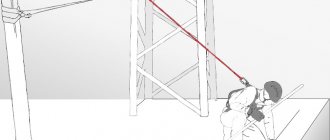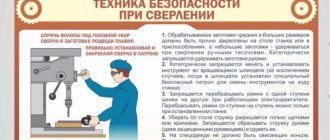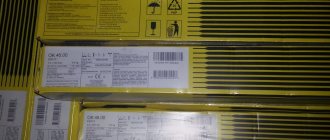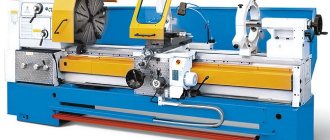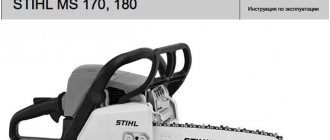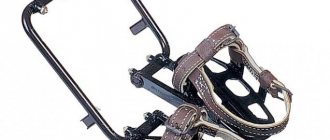When carrying out welding work, physical and chemical processes take place that have a negative impact on the human body. For example, ultraviolet radiation burns the retina of the eyes, the skin of the face and hands. Just a few minutes of such ultraviolet welding radiation level is equal to several tens of hours of exposure to the scorching tropical sun.
But that's not all. The fumes contain microparticles of molten metals, which can cause poisoning, affecting the welder’s respiratory system. There is always the possibility of getting burned from splashes of molten metal. Therefore, it is very important to follow safety rules that are specially developed and take into account all the nuances of welding work.
At manufacturing enterprises, welders are allowed to perform their duties only after instruction. All of them are informed about the impending danger and know perfectly well how to protect themselves from it. Hobbyists working at home should take exactly the same precautions.
Hazards
Safety precautions when carrying out welding work are a collection of preventive actions aimed at minimizing the risk of injury to a person and damage to the workpiece. They are important to follow for the following reasons:
- During the electric welding process, direct (alternating) current is supplied to the device. Careless handling of a working device can sometimes lead to severe electric shock.
- An electric arc can have a negative effect on the visual organs, skin of the hands, and face. This happens due to the excessive brightness of the arc and significant heat release.
- During welding work, gases that are harmful to the human body are released and have a detrimental effect on the respiratory system. High temperatures contribute to the formation of dust and various fumes.
- Welders are always at risk of mechanical injury while performing their duties. Most often this happens when connecting dimensional elements. Therefore, they must first be securely fixed.
- There is a possibility of explosion of gas cylinders used for metal welding. As is known, gas in a reduced state is always explosive.
- It is worth remembering the danger of radiation charging, which arises when checking the quality of the seams made.
Improper use of welding equipment can lead to damage to the organs of vision Source svarkaspec.ru
In their activities, people often use welding devices, which is why special GOSTs and relevant regulatory documents were adopted in a timely manner. Careful adherence to the latter allows you to minimize the risk of injury.
In the room where welding work is carried out, it is imperative to install a powerful ventilation system Source promklimat.ru
Safety precautions when welding with an electric arc
Safety precautions in arc welding are a set of recommendations that must be followed to limit the contact of the master with parts through which the current of the welding unit passes - a terminal, bare wire, metal surface, etc.
Safety precautions for the welder.
Safety rules when performing work using electric arc equipment include the following:
- Ultraviolet and infrared rays have a negative effect on the welder’s body, in particular on vision. To avoid problems in this area, it is recommended to use a protective mask while operating the equipment.
- One of the most dangerous places is the connection of all parts of the unit using wires. For this reason, they are reliably insulated. However, with frequent use, they wear out or burst, so before starting work you need to check their condition.
- When the procedure is performed by a master at a stationary post, the room where he is located should be painted in a light color in order to reduce the level of contrast and brightness of the electric arc. The color should be matte, which will prevent reflections from the welding area. This allows the electric gas operator to do the job quickly and without difficulty.
- Like any technical device, welding can also break down. Often the cause of failure is a violation of the insulation in the transformer area, which provokes the occurrence of puncture. From here, the current enters the metal body of the device itself, which can cause the technician to receive an electric shock. To avoid this situation, the device must be grounded.
- To protect the safety of the welding technician, certain actions must be taken. These include: restricting contact with the metal surface of the operating unit, insulating the holder, using a rubber mat or special shoes made of the same material, as well as the use of non-flammable material - sheet iron, asbestos panel, etc.
- It is also necessary to completely secure the device. It will be necessary to install a circuit breaker before connecting to the electrical network. In a fraction of a second, it will respond to the supply of high-frequency current during a short circuit. In other words, this part will automatically turn off the equipment before the current has time to reach the welder.
Protective means
Safety precautions for electric arc welding require special clothing that will reliably protect the welder. During welding, an arc is formed. The latter is the cause of such radiation:
- infrared – provokes the development of cataracts;
- light – a bright flash blinds;
- ultraviolet - causes pain in the eyes, sometimes causing a burn to the cornea.
Additionally, gases harmful to humans are often released. Once in the body, they contribute to headaches, severe vomiting, and weakness.
The use of protective equipment allows the welder to avoid burns and maintain his health Source svarkaprosto.ru
In this article:
In case of injury at work:
When working as a private master
- a commission was appointed to investigate the causes;
- management will lose bonuses this month;
- Perhaps someone from middle management will be fired indicatively.
- explosions of flammable gases are possible;
- harmful fumes are released;
- the welder is in close proximity to hot objects or flames;
- possible electric shock;
- there are harmful effects of UV rays and bright light.
But for you without eyes or with a damaged heart from an electric shock, this is unlikely to make you feel any better. And if you are partly to blame for what happened, you will also be punished financially. Therefore, the welder himself should be interested in observing safety regulations and demand from management everything necessary for this.
Conditions for storing equipment and consumables
To ensure the safety of people, in order to preserve property, it is important to follow the rules for the preservation and use of welding equipment and components:
- The main thing is to allocate a suitable dry room, protected from all kinds of pests (including rodents). If the hoses become leaky or damp over time, this can cause a fire during welding. Recommended parameters for a warehouse: temperature – 15°C, permissible humidity level – 40%.
- It is best to store electrodes in a cool, dry room. In damp conditions, such consumables become saturated with moisture, making it difficult to create an arc with their help. If this does happen, then wet consumables must be carefully dried in the oven.
- The generator is placed stably so that it does not come into contact with nearby equipment. If it does not have a water seal, then using such a unit for welding is prohibited. The device must be in working order. When it is applied at sub-zero temperatures, the liquid must be monitored. If it freezes, you must first remove the water jam, then use the mechanism.
- The main requirements for all hoses are complete integrity and functionality. They must not be swapped: those that were originally intended for oxygen cannot be used for acetylene. It is important that they are securely fixed to the burner or gearbox with clamps or wire. According to storage standards, such products are placed in rings so that they do not break.
- It is imperative to observe safety when working with gas cylinders. After removing the metal cap, the fitting and valve are checked for external damage. It is strictly prohibited to “knock out” the cap using auxiliary tools; such actions may cause a spark. When opening the valve, you need to make sure that the gas does not get on people standing nearby. Gas containers must be placed at a distance of at least five meters from any source of fire, more than 1 m from heating devices.
If you strictly follow the instructions for storage and operation of the welding machine and consumables, you can be confident in your personal safety.
Welding electrodes cannot be stored in rooms with high humidity, as they absorb moisture and lose their quality Source 1kanat.com.ua
Gas welding and cutting
There is a rule that applies to gas welding and cutting:
- Cylinders deserve attention; they are transported only in an upright position. During transportation, the valves are covered with protective caps. Check the filling of cylinders to avoid a sharp decrease in gas pressure during operation.
- If during operation you hear popping noises from the reverse impact, the gas is shut off in a certain sequence: first acetylene, only then oxygen. For safety reasons, gas generators are turned off strictly according to the instructions. The gas is located at a distance of at least 5 meters from the working area. Hoses are suspended for safety.
- The burner is checked before operation; the presence of oil is especially dangerous - it increases detonation. They look at the injector and gearbox.
- During welding, it is important to maintain a gap between the mouthpiece and the workpiece so that there is constant gas pressure.
Gas welding
Preparing equipment for operation
Before you start welding, it is important to check the functionality of the equipment and prepare the required components. This will subsequently eliminate the occurrence of unforeseen difficulties and will allow you to complete the planned task efficiently.
Sequencing:
- Carefully inspect the unit, auxiliary elements, and consumables for integrity.
- Check the availability of the necessary protective equipment and their condition.
- If work is planned to be carried out in particularly hazardous conditions, an appropriate design should be prepared.
- Pay attention to grounding to eliminate the possibility of electric shock. When the body of the welding unit is reliably grounded, the risk of a short circuit is significantly reduced.
- Be sure to check the cables. During the working process, they should not be located in liquid, as this reduces the reliability of the insulation.
With proper preparation for such an important procedure, most problems can be avoided.
Cylinders with oxygen or acetylene must be transported, stored and operated strictly in accordance with the instructions Source xn--b1ae4ad.xn--p1ai
GENERAL OCCUPATIONAL SAFETY REQUIREMENTS
1.1. This Instruction provides basic labor protection requirements when working on an inverter welding machine for electric arc welding (hereinafter referred to as the welding machine). 1.2. When working on a welding machine, you must perform your duties in accordance with the requirements of these Instructions. 1.3. Persons at least 18 years of age who have passed a mandatory preliminary medical examination in accordance with the order of the Ministry of Health and Social Development of Russia dated April 12, 2011 No. 302n (Appendix No. 1, clause 1.1.4.8 (Welding aerosols), clause 3.3 (Ultraviolet radiation) are allowed to work on a welding machine ), introductory and initial workplace safety briefings, training in safe methods and techniques for performing work, on-the-job training and testing of knowledge in the prescribed manner and having received permission to work independently. 1.4. When working on a welding machine, the employee must undergo training in labor protection in the form of: introductory briefing, initial briefing at the workplace, repeated briefing, unscheduled briefing, targeted briefing and special training within the scope of the training program for the profession, including labor protection issues and requirements of job responsibilities in the profession. 1.5. Introductory briefing is carried out by a service employee labor protection or the employee replacing him, with all those hired under a program approved by the employer and agreed upon with the trade union committee or other representative body of workers. 1.6. Initial briefing at the workplace is carried out by an official determined by order individually before the start of the employee’s production activities under the occupational safety program for the profession. 1.7. Repeated instruction is carried out according to the initial instruction program once every six months by the immediate supervisor of the work individually or with a group of workers of similar professions, including combined work. 1.8. Unscheduled briefing is carried out by the immediate supervisor of work when there is a change in instructions on labor protection, technological process, technological equipment, at the request of supervisory authorities, etc., which determine the scope and content of the briefing. 1.9. Targeted instruction is carried out by the immediate supervisor when performing one-time work that is not related to the direct responsibilities of the employee by profession. 1.10. Before being allowed to work independently, an employee must undergo an internship under the supervision of an experienced worker (for 3-14 shifts, depending on length of service, experience and the nature of the work). 1.11. When working on a welding machine, a worker may be exposed to dangerous and harmful production factors: - a dangerous level of voltage in the electrical circuit, the closure of which can occur through the human body; — increased level of electromagnetic radiation (pulse); — increased content of harmful vapors and aerosols in the air of the working area; — intense radiation from the welding arc in the optical range (ultraviolet, visible, infrared); — intense thermal (infrared) radiation of welded products; — sparks, splashes and emissions of molten metal and slag; — increased surface temperature of equipment, workpieces and parts; — increased noise level in the workplace; — increased level of local vibration; — sharp edges, burrs and roughness on the surface of workpieces, equipment parts and tools; — flying fragments from the working parts of the equipment in case of their possible destruction, deformable material and scale; — insufficient illumination of the working area; — static load on the shoulder girdle; — physical overload; - fire and explosion hazard. 1.12. Sources of harmful and dangerous production factors: - faulty production equipment or its improper operation; — faulty electrical equipment or improper operation; — sharp edges, burrs and roughness on the surface of equipment and tools; — absence, malfunction, improper use of personal protective equipment; — absence, malfunction, improper operation of lighting devices; — non-fulfillment or improper fulfillment by an employee of a job description, labor protection instructions, internal labor regulations, local regulations regulating the procedure for organizing labor protection work, and working conditions at the site. 1.13. When working on a welding machine, the employee notifies his immediate supervisor about any situation that threatens the life and health of people, about every accident that occurs at work, about a deterioration in his health, including the manifestation of signs of an acute disease. 1.14. When working on a welding machine, the employee is provided with special clothing, safety shoes and personal protective equipment in accordance with current standards. 1.15. Issued special clothing, special shoes and personal protective equipment must correspond to the nature and conditions of work, ensure labor safety, and have a certificate of conformity. 1.16. Personal protective equipment for which there is no technical documentation is not allowed for use. 1.17. Personal clothing and workwear must be stored separately in lockers and a dressing room. It is prohibited to take protective clothing outside the enterprise. 1.18. When working on a welding machine, the employee should: - perform work that is part of his duties or assigned by the administration, provided that he is trained in the rules for the safe performance of this work; — strictly follow the operating rules of the welding machine established by the manufacturer; — correctly use workwear, safety shoes and other personal protective equipment (gloves, protective mask, welding helmet, earplugs, etc.); - be attentive, do not be distracted by extraneous matters and conversations; — when working together, coordinate your actions with the actions of other workers; — having noticed a violation of labor protection requirements by another employee, warn him about the need to comply with them; - keep the workplace tidy and clean throughout the working day, avoid cluttering the approaches to the workplace, use only designated passages; — know and strictly comply with the requirements of labor protection, fire safety, industrial sanitation, Rules for the technical operation of consumer electrical installations; — comply with the requirements of this Instruction, other local regulations on labor protection, fire safety, industrial sanitation, regulating working conditions and the procedure for organizing work at a specific facility; — timely and accurately comply with internal labor regulations, observe labor discipline, work and rest regime; - observe the established working hours, regulated breaks in work; - strictly carry out, within the established time frame, the orders and instructions of the enterprise management, officials responsible for the implementation of production control, as well as instructions of representatives of state supervisory authorities; — apply safe work practices; - treat the employer’s property with care; - be able to provide first aid to victims, use fire extinguishing equipment in the event of a fire, call the fire department. 1.19. Smoking and eating are permitted only in areas specially designated for this purpose. 1.20. Persons who violate the requirements of this instruction may be held accountable in the manner prescribed by the legislation of the Russian Federation.
Rules for welding work
Compliance with safety precautions when welding eliminates the possibility of severe injury to people. Particular attention should be paid to the following requirements:
- You cannot work in the rain or snow. Excessive humidity provokes a significant increase in electrical conductivity. In case of bad weather, it is advisable to erect a reliable canopy.
- It is unacceptable to be distracted while working; it is important to carefully monitor the ignition and combustion process. If this safety rule is not followed, there is a high risk of damage to the products being processed.
- Under any circumstances, use protective clothing: it will prevent burns.
- Welding should be carried out only in a special mask.
- In case of a long break, the unit should be disconnected from the power source.
- Do not twist the used cables or form them into skeins. It is also necessary to ensure that the cable insulation is not damaged during the work process. Sometimes this happens due to accidental contact with drops of oil or liquid metal.
- It is unacceptable to work in wet clothes. The presence of moisture increases the electrical conductivity of the latter, which can lead to life-threatening electric shock.
- It is recommended to use a respirator even in cases where welding takes place outdoors. It provides protection to the respiratory system from harmful vapors.
- When performing high-altitude welding work, safety devices should be used.
In the above process, outside help may be needed to fix any part. Therefore, the presence of assistants is always desirable.
At enterprises, many welding operations are performed in an automated mode, which reduces the time a person spends in the welding zone Source knn-systems.com
To gain access to the site, an employee must?
When hiring, all future employees are subject to certain requirements. Safety precautions when welding must be observed. Among the features of employee access to the site, we note the following points:
- Knowledge of safety precautions related to the supply of electricity must be checked.
- Only persons over 18 years of age may be allowed to perform welding work and enter the work area. At the same time, they must undergo training and obtain the appropriate permit.
- Proficiency testing may be carried out from time to time.
If a future employee does not have the appropriate education and skills, then he should not be allowed to work. The welder must also prevent strangers from entering the work area, as they may also be harmed.
During welding work, it is strictly prohibited
When welding, you must take into account some prohibitions. The main ones are the following:
- It is unacceptable to work in a damaged protective helmet (for example, if there are gaps).
- If there is high humidity in the room or the ventilation system is not working, then welding work should be abandoned.
- It is not recommended to process a part if it is poorly secured, located in a canopy, or even held by hand.
- It is unacceptable to weld under pressure.
- It is prohibited to work in places where containers with flammable compounds are located nearby.
Important! Under no circumstances should you use equipment with significant mechanical damage. It should be checked periodically for functionality.
When performing welding work, it is prohibited to use damaged welding equipment that has not undergone preliminary testing Source ismith.ru
Welding workplace equipment
Safety regulations require proper organization of the welder’s workplace. This includes:
Lighting is allowed with a 220 V power supply only in a stationary place, when the lamp is fixed high above the table. If a welder needs light (for working in a tunnel, tank, mine), low-voltage lamps with a voltage of 12 V are used.
When working at height, a safety belt attached to a reliable element of the supporting structure is required. If you have to cook while standing in water (a well or tunnel is flooded), you should wear rubber work boots and rubber gloves. The device must be placed in a dry place, and all cables must be laid on top (contact with water is unacceptable). There should be a person near the welder to supervise. The second assistant stands next to the device and is ready to turn it off at any time.
Welding completion procedure
The welding process must be completed correctly. This will avoid unwanted consequences.
Sequencing:
- Turn off power.
- Wait until the created seam has completely cooled. Safety precautions do not allow working with hot metal.
- Thoroughly clean de-energized welding equipment and check it for integrity.
- Inspect the formed seam for quality.
At the final stage of welding, you need to collect all the equipment and move it to a permanent storage location.
Checking the quality of cooled welds is carried out using special equipment Source dsnspb.ru
The need to follow the rules
Regardless of the type of equipment used, the welder and other people present at the work site are affected by negative factors.
The need to comply with the rules is explained by the possibility of the following traumatic situations:
- sparks getting on the welder’s clothes;
- burning shoes made of fusible materials;
- injury to the skin of the face and organs of vision by hot metal vapors;
- ignition of materials located on the site due to the spread of sparks;
- burns from particles falling on the skin;
- high-intensity electric shock;
- falling of poorly fixed parts of metal structures.
Emergency welding work
When restoring significant mechanisms and objects that were seriously damaged following an accident, it is also necessary to comply with labor protection requirements. Among the most important it should be noted:
- Repairs using welding are unacceptable if the damaged pipeline is under significant pressure.
- Safety precautions do not allow welding work near explosive objects.
- Under any circumstances, the actions taken should not threaten human health.
For emergency situations, special rules related to welding conditions are developed.
Emergency welding work, which is often carried out in particularly difficult conditions, also requires compliance with safety precautions Source luganskgaz.org
electrical safety
The Safety Rules have a special section that regulates the work with electrical circuits. They are created taking into account the damaging factors that can be generated by power supply systems. According to accepted standards, electric current with a voltage of over 110 Volts is dangerous to life, and a current of more than 0.05A is dangerous.
In order not to harm your health, a specialist must adhere to simple safety rules:
- for lighting it is advisable to use sources with a voltage of 12V;
- the maximum permissible no-load voltage should not exceed 90V;
- Before turning on the equipment, its grounding must be checked;
- Always check the condition of the insulation of power and working cables. There should be no tears, cracks or other damage;
- the power supply must go through a distribution board with installed fuses;
- Do not use a cable longer than 10 meters;
- Twisting or other connections of the power cable are not allowed. As an exception - contact through a coupling connection.
What can be used as a return wire for electric welding?
As a return wire connecting the product being welded to the welding current source, flexible wires can be used, as well as, where possible, steel bars of any profile of sufficient cross-section. The return wire must be insulated in the same way as that connected to the electrical holder. The use of metal building structures of buildings, communications and non-welded technological equipment as a return wire of the grounding network is prohibited.
The individual elements used as the return wire are carefully connected to each other (by welding or using bolts, clamps or clamps). In arc welding installations, if necessary (for example, when making circular seams), it is possible to connect the return wire to the product being welded using a sliding contact.
